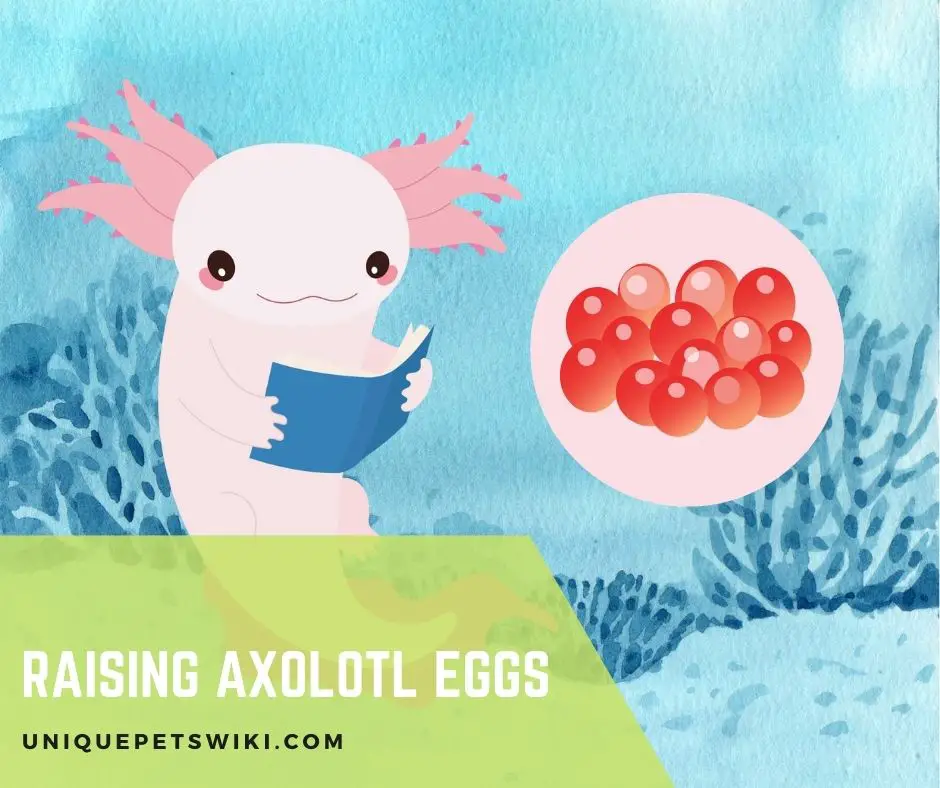Perhaps you have heard from several experienced breeders that it’s hard to hatch and raise axolotl eggs from hatchlings to about 3 months old.
Hatching and raising axolotl eggs is not so difficult. But without a doubt, it is very time demanding/intensive.
This is probably one of the reasons it is believed that axolotl eggs are difficult to raise, especially for beginners.
So to do it right and have the best results you will need to learn the basic principles – what you should do and what you should not do.
That said, this article is going to walk you through all the processes in hatching and raising baby axolotls till about 3 months old. Keep reading to learn more!
Contents
Steps on How to Raise Axolotl Eggs
Remember that the first thing you’ll do when your axolotl lays eggs is to separate the eggs or get them into a new tank/container that will serve as an incubation area till they hatch.
To do this you’ll need 4 – 5 buckets or a large container and a turkey baster.
- Filled ⅓ of the container with water and keep the temperature at 72 degrees Fahrenheit (22 degrees Celcius). At this temperature, the eggs will hatch in 15 days.
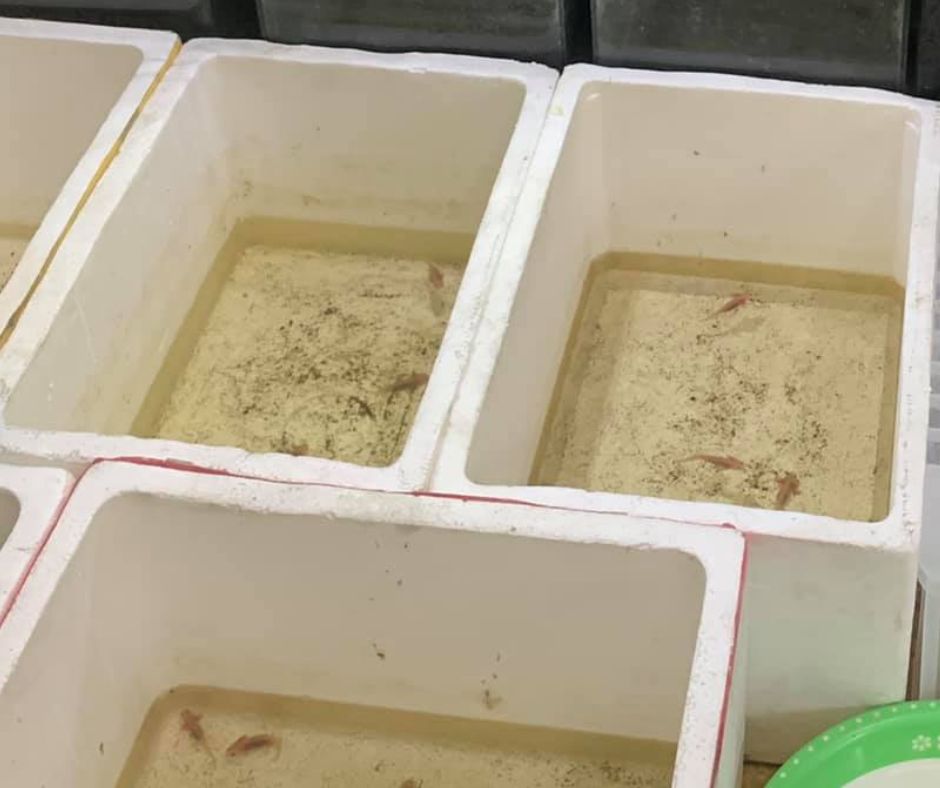
Warmer water temperatures (maximum of 25 °C/77 °F) will speed up the hatching process, resulting in eggs hatching in less than 14 days.
A lower temperature (e.g., 18 °C / 64 °F) will cause them to take longer, possibly over 20 days.
Add some pond weed or oxygenating plants to the container.
Put a thermometer in the container to ensure that the temperature doesn’t fluctuate beyond the high normal of 25 °C/77 °F and the low normal of 18 °C / 64 °F.
- Using a Turkey baster, suck up the eggs your female has laid to the container that you have prepared for the eggs. Make sure the container with the eggs is kept in a cold, dark environment that is not exposed to sunlight.
From here, you can monitor as the eggs grow. You can also tell the eggs that were fertilized and those that were not.
Initially, when your female axolotl just laid the eggs, they appear dark brown in color and are enclosed in a jelly shell.
After a few days (usually about a week), the eggs will develop into a white bean shape in the jelly shell.
Once this happens, if you notice that some eggs are still dark brown in color or are having a big white blob or appearing cloudy, you have to understand that either of these three things are happening to your eggs.
- The eggs that are still dark brown need more time to grow as not all the eggs will develop at the same time.
- The eggs with a big white blob simply mean they were not fertilized.
- A cloudy egg is a sign that the egg is dead.
If your axolotl laid up to 100 or more eggs, you’ll need to incubate them in several containers of about 25 in each.
This is to avoid the eggs from touching one another, because if they constantly collide with one another they may not hatch properly.
- As the eggs hatch, separate them immediately to a new tank from those that are yet to hatch. This is because they might end up eating the eggs that are yet to hatch.
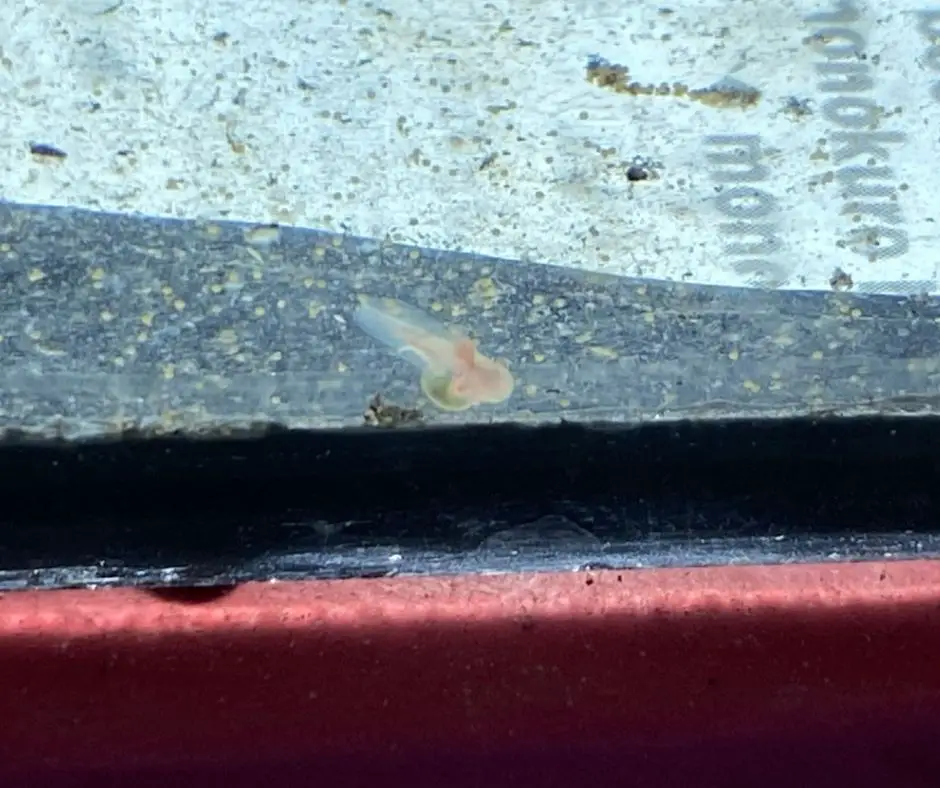
Tip: As soon as (or before) you set up a tank for your hatchlings, you can add some daphnia to your tank. If done well the daphnia will breed, providing plenty of food for your newly hatched axolotls.
Once hatched, they resemble a tadpole and a fish fry even in size and will be ready to eat a day or two after.
They only eat live food and will snap at anything small enough that swims by. So it’s advisable to keep them in smaller tanks where they can access food without stress.
As hatchlings, feed only live daphnia and brine shrimp. After a few weeks when they grow larger, introduce live bloodworms to their diet.
At about 4 – 5cm mark, start feeding them live earthworms, pellets, woodlice, little slugs, crickets, and frozen bloodworms.
Raising Axolotl Eggs: Complete Guide for Beginners
Caring for axolotl eggs involves basically three stages. First, separating the eggs from their mother into a new tank (an incubation center).
Secondly, watching them develop till they hatch, and lastly, getting them set up in their new home (tank).
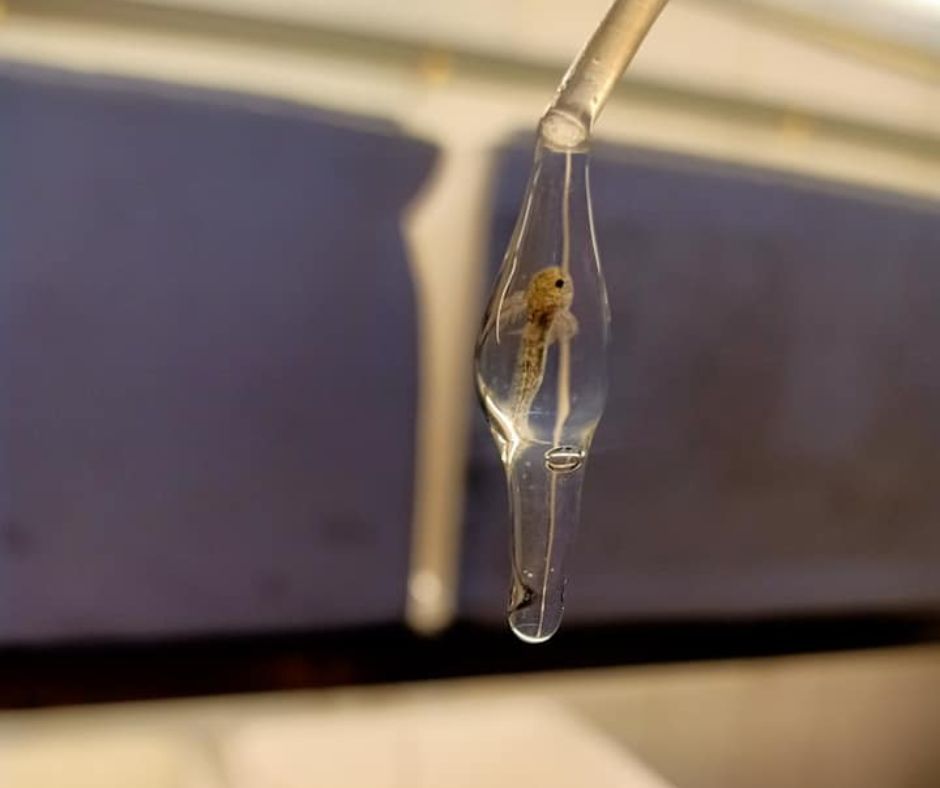
To get this done right you need the following instruments:
- Buckets or large containers to keep the eggs.
- Tanks or containers for hatchlings.
- Turkey Baster.
- A fine net.
- A less fine net.
- A tube to siphon water.
- A thermometer.
When your female axolotl blesses you with some eggs, you must decide immediately what you are going to do with the eggs. This is very important.
The reason is that axolotls lay lots of eggs at a time – usually numbering up to 1500 eggs. This is lots of eggs and a lot of responsibility for someone living in a small apartment or someone that is living on a budget.
Ideally, about 20 – 30 eggs is a reasonable starting point; if you keep too many you’ll have trouble keeping them adequately nourished.
Therefore, if you are not fully prepared to take on such a responsibility financially, with your time or even a large home space; do not raise the eggs.
Sell the eggs out to an experienced breeder who can care for them. Even if you keep the eggs till they hatch, sell the hatchlings out to people who can care for them.
2 Pieces Aquarium Coral Feeder with 2 Pieces Stainless Steel Feeding Long Tweezers
- Aquarium feeding set: the package includes 2 pieces coral feeder tubes in different sizes, easy to fit your different needs, and 2 pieces straight and curved tweezers, nice combination for feeding your little pets in the water; The stainless steel straight and curved tweezers can both feed and clean up the mess inside the fish tank
- Reliable material and easy to use: made of quality plastic and rubber material, the coral spot feeder is safe for fish and corals, clearly printed with 10ml, 15ml, 20ml, 30ml, 40ml and 50ml measurements for easy to read, ensuring that you know how much you are dispensing and prevents overfeeding; While the aquarium feeding tweezers are made of stainless steel with coating, durable and not easy to be rusted under water
- Long to keeps hands dry: the size of coral feeder is approx. 11.2 inch/ 28.5 cm, and the other one is approx 17.7 inch/ 45 cm long, helping you arrive at deep and hard-to-reach area, you can feed liquid food to corals, and the tweezers are approx. 10.62 inch/ 27 cm in length, they are good and practical tools for aquarium plants or reptiles
- Wide range of applications: you can feed liquid phytoplankton to corals or other aquatic animals by using coral feeder and tweezers, which is easy to control and prevents your hands from getting wet, these feeding tools can be applied in marine reef tank to feed coral, reef, anemones, lionfish, brine shrimp and so on for a long time
- Warm tips: please ensure that the coral feeder tube is washed and cleaned before use; Turn off your circulation pumps when feeding your coral or fish; After using the tweezer, please remember to rinse it with water and get it dried
Last update on 2022-12-30 / Affiliate links / Images from Amazon Product Advertising API
How to Get Axolotl Eggs
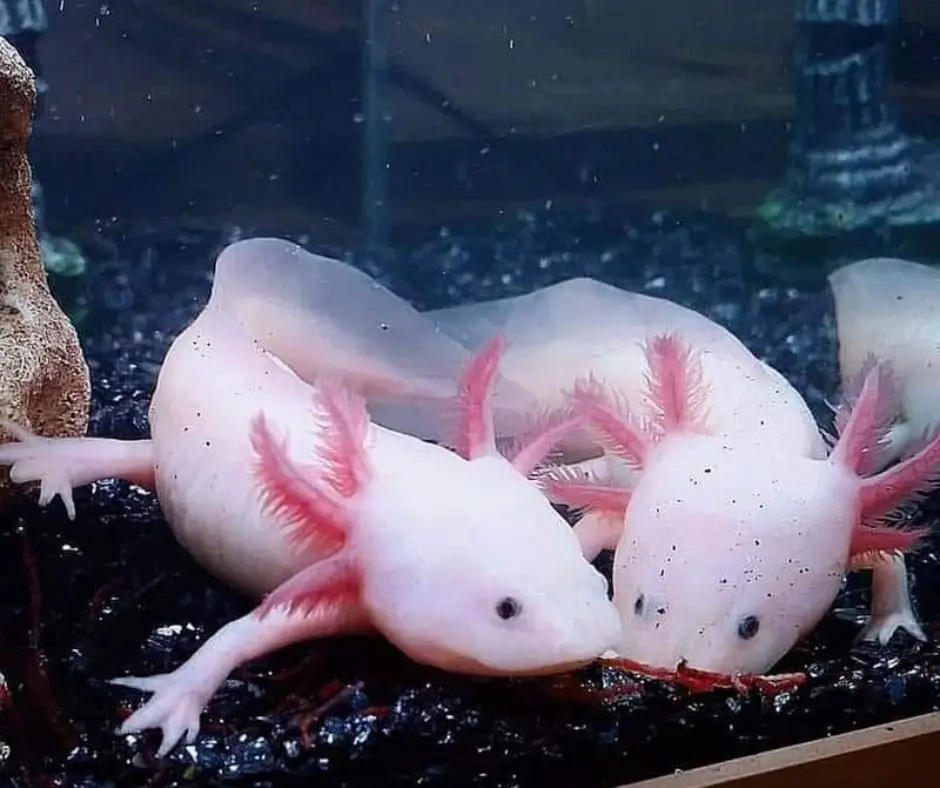
You can get axolotl eggs in two ways – first by breeding them yourself and secondly, by buying them from other breeders.
Keep in mind that axolotls lay several eggs at a single spawn, usually numbering between 100 and sometimes up to 1500.
What this means is that you’ll need lots of space, time, and resources to care for axolotls of such a number.
Hence, it’s advisable that instead of breeding your axolotl yourself since you are not raising the eggs for selling purposes, you should buy from private breeders who do.
However, if you find it lucrative to start a business around axolotl eggs or even if you feel you can manage many axolotls, you will need proper knowledge of how to breed your female axolotl.
The article “Breeding Axolotl” has all the details you need including what you’ll need to start breeding axolotls and the dos and don’ts.
Even if you want to buy from private breeders, “Where Can I Buy Axolotl Eggs?” is an article with lists of credible vendors you can buy viable axolotl eggs from.
We advise you to weigh the pros over the cons and make your decision.
Maintain Eggs
To ensure that eggs hatch all at the same time with minimal or no dead eggs, ensure you do the following:
- Ensure the eggs should sit in the container in a single layer, covered with 1 inch of water.
- If you want to use more water in the container, use a bubbler to help give the eggs oxygen.
- Keep the water temperature at 64 degrees Fahrenheit.
- Do water changes for the eggs once every few days.
Rubbermaid 4-Piece Brilliance Food Storage Containers with Lids for Lunch
- Rubbermaid Modular Food Storage Containers can hold pasta, baking ingredients, or other pantry staples; save space and keep pantry organized
- Great for pet food; easy to clean and scoop food from, and tight lids keep out moisture and humidity
- Lids snap tight to help keep food fresh
- Containers stack for compact storage
- Thick, durable container walls for everyday use
Last update on 2022-12-30 / Affiliate links / Images from Amazon Product Advertising API
Remove Dead Axolotl Eggs
Axolotls lay many eggs but not all of the eggs will hatch. Some will die but the percentage is low compared to those that will live. Signs that an axolotl egg is dead include:
- Looking milky/grey, swollen, and cloudy.
- Has air bubbles.
- In the early stage of axolotl eggs’ life, they are brown, grey, or white solid-looking circles. But when some eggs are dead, they look fluffy and expand.
- The embryo does not develop to a bean shape after about a week.
So the best thing to do when you notice that some of your axolotl eggs are dead is to remove them from the container or tank so that the dead ones will not infect the viable ones.
How Long Does It Take to Hatch Axolotl Eggs?
Ideally, it takes 15 days for axolotl eggs to hatch under an ideal temperature of 72 degrees Fahrenheit (22 degrees Celcius) and with enough oxygen.
However, it can take longer or lesser than 15 days depending on the temperature of the water. If the temperature is high (warm) the eggs will develop faster and hatch even in less than 14 days.
Whereas if the temperature is cool, the eggs will take a longer time to develop and can take up to 20 – 30 days to hatch.
The maximum high water temperature you can go is 25 °C/77 °F and the minimum low is 18 °C / 64 °F. These ranges are considered ideal for axolotl eggs. Temperature fluctuations beyond these ranges will make the eggs not to hatch.
Also read: Axolotl Temperature Control
What Is The Survival Rate of Axolotl Eggs?
Axolotl eggs have a high survival rate compared to other species of salamanders. Axolotls lay several eggs in a single spawn and only a few will die before hatching. Many of them will survive.
The percentage survival rate is estimated at 90% – 95%. The 10% – 5% often die because of several reasons which include:
- Poor water quality.
- Wrong water temperature – either too hot or too cold.
- Genetic abnormalities or mutations that cause the growth of the embryo to stop.
- Too many eggs in one container. As many eggs your female axolotl will lay should not be housed/incubated in one small container. This will alter the ideal environment they should be kept.
- Perhaps the dead eggs were not fertilized.
What Do Newly Hatched Axolotls Look Like?
Newly hatched axolotls looked like a tadpole or a fish fry, with just their head, tiny gills, and a long tail.
They measure about 10 – 13cm (0.5 inches) and develop other body parts (the fore and hind legs) as they grow.
How fast they grow depends on how much nutritious food you’re feeding them and the condition of their environment. They grow fast if well feed.
Also read: Why Is My Axolotl Not Growing?
Hatchlings Baby Care
The most important parts of caring for axolotl hatchlings and babies are feeding them ideal foods and quality water maintenance.
As stated earlier, start by feeding them live brine shrimp and daphnia.
After a few weeks, proceed to live bloodworms and then earthworms, pellets, woodlice, little slugs, crickets, and frozen/thawed foods.
Note that variety is premium in giving them a balanced and nutritious diet.
In maintaining good water quality, you’ll need to do about a 10% water change once or twice a week and a full water change every 4 – 6 weeks.
When you are doing a 10% daily or weekly water change, you only need to siphon part of the water from the bottom of the tank and replace it with fresh dechlorinated water.
Removing part of the water from the bottom will suck up all the dirt that settled at the bottom of the tank and help keep the tank clean till you do a full water change.
You can use a fine net to remove waste and impurities in the water.
When you do a full clean, wash and rinse off all aquarium plants, decor, and tank. Refer to Axolotl Babies Hatchling for steps and what you’ll need.
Marina Blue Fine Nylon Net with Handle
- Made with high quality materials; the soft nylon woven mesh material is perfect for gently scooping fish
- Allows for easy fish tank maintenance
- Great to use in either a freshwater fish tank or a salt water fishtank
- The aquarium fish net is 4”x4” (10 cm x 10 cm)
- Handle is 10” (25 cm) long; allows for easy reach
Last update on 2022-12-30 / Affiliate links / Images from Amazon Product Advertising API
Wrapping Up
It’s no secret that Axolotls are awesome pets and that they can lay eggs in hundreds to thousands in a spawn.
Raising axolotl eggs is a fun but demanding hobby/activity. Without the right care, they will die.
Axolotl eggs need a specific environment to ensure that they develop, hatch, and continue to grow.
When they are hatched, they need a variety of nutritious diets and a comfortable environment to grow and stay healthy.
Considering what is involved to raise them, people with less experience, ample space, and not enough money are always advised to sell their axolotl eggs to private breeders who breed them for profit.
